Tsushima tragedy
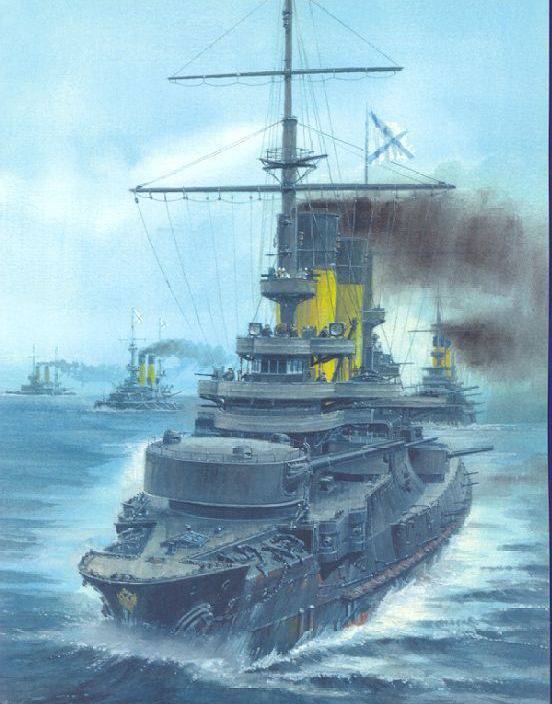
110 years ago, on May 27-28, 1905, the Tsushima naval battle took place. This naval battle was the last decisive battle of the Russo-Japanese War and one of the most tragic pages in the Russian military annals. Russian 2nd Pacific Squadron fleet under the command of Vice Admiral Zinovy Petrovich Rozhdestvensky suffered a crushing defeat from the Imperial Navy of Japan under the command of Admiral Togo Heihatiro.
The Russian squadron was destroyed: 19 ships were sunk, 2 were blown up by their crew, 7 ships and ships were captured, 6 ships and ships were interned in neutral ports, only 3 ships and 1 transport broke through to their own. The Russian fleet lost a combat core - 12 armored ships intended for linear squadron combat (including 4 newest battleships of the Borodino class). Out of more than 16 thousand of the squadron's crew, more than 5 thousand people died and drowned, more than 7 thousand people were taken prisoner, more than 2 thousand were interned, 870 people came out to their own. At the same time, Japanese losses were minimal: 3 destroyers, more than 600 people were killed and wounded.
The Tsushima battle was the largest in the pre-dreadnought armored fleet era and finally broke the will to resist the military-political leadership of the Russian Empire. Tsushima did terrible damage to the Russian navy, which had already lost the 1 Pacific Squadron in Port Arthur. Now the main forces of the Baltic Fleet have perished. Only by great efforts the Russian Empire was able to restore the fleet’s combat capability for the First World War. Tsushima disaster inflicted enormous damage on the prestige of the Russian Empire. Petersburg succumbed to social and political pressure and went to peace with Tokyo.
It is worth noting that in military-strategic terms, Tsushima meant little, despite the heavy losses of the fleet and the negative moral effect. Russia lost control of the situation at sea for a long time, and the fall of Port Arthur with the death of the 1 Pacific squadron put an end to this question. The outcome of the war was decided on land and depended on the moral-volitional qualities of the military-political leadership and the resources of the countries. Japan was completely depleted in military material, economic, financial and demographic terms.
The patriotic upsurge in the Japanese Empire has already faded, overwhelmed by material difficulties and severe losses. Even the Tsushima victory triggered only a brief flash of enthusiasm. The human resources of Japan were exhausted, among the prisoners were old men and almost children. There was no money, the treasury was empty, despite the financial support of the United States and England. The Russian army, despite the failure lane, mainly caused by unsatisfactory command, only entered into full force. A decisive victory on land could lead Japan to a military-political catastrophe. Russia had the opportunity to throw the Japanese from the mainland and take Korea, return Port Arthur, and win the war. However, St. Petersburg broke down and, under pressure from the “world community,” went to a shameful world. Russia was able to take revenge and regain the honor only under IV Stalin, in 1945 year.
Beginning of the campaign
Underestimation of the enemy, shappy-handed moods, extreme self-confidence of the government, as well as sabotage of certain forces (like S. Witte, who convinced everyone that Japan would not be able to start a war earlier than 1905 due to lack of money), led to that Russia did not have in the Far East, sufficient forces, as well as the necessary shipbuilding and repair capacities. At the very beginning of the war, it became obvious that the Port Arthur squadron needed to be strengthened. The need to strengthen the naval forces in the Far East was repeatedly pointed out by Admiral Makarov, but nothing was done during his lifetime.
The death of the battleship "Petropavlovsk", when almost the entire crew of the flagship was killed, along with the commander of the squadron Makarov, had a negative effect on the combat capability of the Pacific squadron. Makarov did not find an adequate replacement for the war, which was another evidence of the general degradation of the Russian empire and, in particular, of the rottenness and weakness of the military leadership. After this, the new commander of the fleet in the Pacific, Nikolai Skrydlov, raised the question of sending significant reinforcements to the Far East. In April 1904, the principal decision was made to send reinforcements to the Far East. The 2 Pacific Squadron was headed by Chief of the Main Naval Staff Zinovy Petrovich Rozhestvensky. Younger flagships were appointed Rear Admiral Dmitry von Felkerszam (he died a few days before the Tsushima battle) and Oskar Adolfist Enquist.
According to the original plan, the 2-I Pacific Squadron was to strengthen the 1-Pacific Squadron and create a decisive naval superiority over the Japanese fleet in the Far East. This led to the release from the sea of Port Arthur, the violation of the sea communications of the Japanese army. In the future, this should have led to the defeat of the Japanese army on the mainland and the lifting of the siege of Port Arthur. With such a correlation of forces (battleships and cruisers of the 2 th Pacific Squadron plus squad battleships of the 1 th Pacific Squadron), the Japanese fleet was doomed to defeat in open battle.
The formation of the squadron proceeded slowly, but the events in the Yellow Sea on August 10, 1904, when the 1st Pacific Squadron under the command of Vitgeft (died in this battle) could not use the available opportunities to inflict serious damage to the Japanese fleet and break through part of the forces into Vladivostok, forced speed up the start of the hike. Although after the battle in the Yellow Sea, when the 1st Pacific Squadron practically ceased to exist as an organized combat force (especially with regard to morale), it refused to break through to Vladivostok and began to transfer people, guns and shells to the land front, the campaign of Rozhdestvensky's squadron had already lost original meaning. By itself, the 2nd Pacific Squadron was not strong enough for independent action. A more sensible solution would be to organize a cruising war against Japan.
On August 23, a meeting of representatives of the maritime command and some ministers was held in Peterhof under the chairmanship of Emperor Nicholas II. Some participants warned against the hasty departure of the squadron, pointing to poor preparation and weakness of the fleet, the difficulty and duration of the sea voyage, the possibility of the fall of Port Arthur before the arrival of the 2 Pacific Squadron. It was proposed to postpone the dispatch of the squadron (in fact, it had to be sent before the start of the war). However, under pressure from the maritime command, including Admiral Rozhestvensky, the question of dispatch was resolved positively.
The completion and repair of ships, supply problems, etc., delayed the exit of the fleet. Only September 11 squadron moved to Revel, stood there for about a month and moved to Libau to replenish coal reserves and accept materials and cargo. 15 October 1904 d. 2 Squadron left Libava as part of 7 battleships, 1 armored cruiser, 7 light cruisers, 2 auxiliary cruisers, 8 destroyers and a detachment of transports. Together with the detachment of Rear Admiral Nikolai Nebogatov, which later joined the forces of Rozhestvensky, the 2 Pacific squadron reached 47 naval units (of which 38 was combat units). The main combat force of the squadron consisted of four new squadron battleships of the Borodino type: "Prince Suvorov", "Alexander III", "Borodino" and "Eagle". More or less they could have been supported by the high-speed battleship Oslyabya, but he had a weak reservation. Skillful use of these battleships could lead to the defeat of the Japanese, but this chance was not used by the Russian command. The squadron planned to increase the cruising component by purchasing 7 cruisers abroad, in order to strengthen the strength of Rozhdestvensky's squadron, but this was not possible.
In general, the squadron was very diverse in shock power, booking, speed, maneuverability, which seriously worsened its combat capabilities and became the cause of defeat. A similar negative picture was observed in the personnel, both command and private. The personnel recruited hastily, he had a weak combat training. As a result, the squadron was not a single fighting organism and could not become one during the long march.
The campaign itself was accompanied by big problems. It was necessary to go about 18 thousand miles, not in the path of its own repair base and supply points. Therefore, the issues of repair, supply of ships with fuel, water, food, crew treatment, etc. had to be resolved by ourselves. To avoid a possible attack by Japanese destroyers on the way, Admiral Rozhdestvensky of the squadron route kept a secret, deciding to enter the French ports without prior approval, relying on the military alliance of Russia and France. The supply of coal was transferred to a German trading company. She was supposed to put coal in the places indicated by the Russian naval command. Some foreign and Russian companies took over the supply. For repairs on the way they took with them a special steamboat workshop. This vessel and a number of other transports with cargoes of various purposes made up the floating base of the squadron.
Additional stockpiles of ammunition needed for firing practice were loaded onto Irtysh transport, but shortly before the start of the march an accident occurred on it and the transport was delayed for repair. Ammunition removed and sent by rail to Vladivostok. “Irtysh”, after repair, caught up with the squadron, but without shells, delivering only coal. As a result, so poorly trained crews lost the opportunity to practice shooting on the road. To clarify the situation on the way to all the states, near the shores of which the Russian fleet passed, special agents were sent, who were supposed to monitor and inform about everything Admiral Rozhestvensky.
The campaign of the Russian squadron was accompanied by rumors about the ambush of Japanese destroyers. As a result, the Hull incident occurred. Because of the mistakes of the command in the construction of the squadron, when the squadron passed on Dogger Bank on the night of October 22, the battleships first attacked English fishing vessels, and then fired on their cruisers Dmitry Donskoy and Aurora. The cruiser "Aurora" received several injuries, two people were injured. October 26 squadron came to Spanish Vigo, where she stopped to investigate the incident. This led to a diplomatic conflict with England. Russia was forced to pay a large fine.
November 1 The Russian ships left Vigo and on November 3 arrived in Tangier. Having immersed fuel, water and food, the fleet, according to the previously developed plan, was divided. The main part of the 2 Pacific squadron, including new battleships, bypassed Africa from the south. Two old battleships, light ships and transports under the command of Admiral Völkerzam, who could pass the Suez Canal through their draft, moved through the Mediterranean and Red Sea.
The main forces of 28-29 December came to Madagascar. 6-7 January 1905 was joined by the Völkersam squad. Both groups joined in the bay Nosi-be on the west coast of the island, where the French allowed parking. The march of the main forces to bypass Africa was extremely difficult. Before the Canary Islands, British cruisers followed our ships. The situation was tense, the guns loaded and the squadron was preparing to repel the attack.
Along the way there was no good parking. Coal had to be loaded directly into the sea. In addition, the squadron commander, in order to reduce the number of stops, decided to make long transitions. Therefore, the ships took a large amount of additional coal. For example, new battleships instead of 1 thousand tons of coal took 2 thousand tons, which, with their low stability, was a problem. In order to accept such a large amount of fuel, coal was placed in rooms that were not designed for this purpose - batteries, residential decks, cabin, etc. This greatly complicated the life of the crew, and so suffered from the tropical heat. Loading itself with ocean waves and intense heat was difficult, taking a lot of time from crews (on average, battleships took 40-60 tons of coal per hour). People exhausted by hard work could not rest properly. In addition, all the premises were littered with coal, and it was impossible to engage in combat training.
Photo source hike: http://tsushima.su
Change task. The continuation of the campaign
In Madagascar, the Russian squadron stood until March 16. This was due to the fall of Port Arthur, which destroyed the initial tasks of the squadron. The initial plan to unite the two squadrons in Port Arthur and intercept the strategic initiative from the enemy was completely destroyed. The delay was also associated with complications in fuel supply and the problems of repairing ships in the roadstead.
Common sense demanded that the squadron be withdrawn. The news of the fall of Port Arthur even inspired Rozhestvensky to doubt the expediency of the march. True, Rozhestvensky confined himself only to the resignation report and hints about the need to return the ships. After the end of the war, the admiral wrote: “If I had at least a spark of civil courage, I would have to shout to the whole world: take care of these last fleet resources! Do not send them to be exterminated! But I didn’t have the right spark. ”
However, the negative news from the front, where after the battle of Liaoyan and Shahe and the fall of Port Arthur, the battle of Mukden occurred, which also ended with the withdrawal of the Russian army, forced the government to make a fatal mistake. The squadron was supposed to arrive in Vladivostok, and this was an extremely difficult task. At the same time, only Rozhdestvensky believed that the breakthrough of the squadron to Vladivostok would be a success, at least at the cost of losing some of the ships. The government still believed that the arrival of the Russian fleet at the theater of military operations would change the entire strategic situation and allow it to establish control over the Sea of Japan.
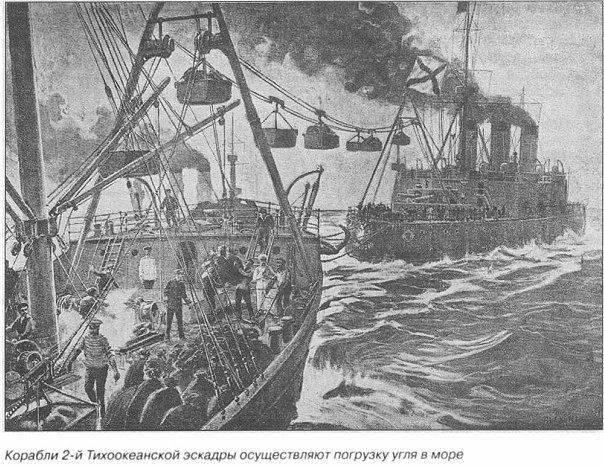
Back in October 1904, the famous naval theorist 2 rank captain Nikolai Klado, under the pseudonym Priboy, published a series of articles in the newspaper Novoye Vremya on the analysis of the Pacific Squadron 2. In them, the captain gave a detailed analysis of the performance characteristics of our and enemy ships, comparing the training of naval command and crews. The conclusion was hopeless: the Russian squadron had no chance in a collision with the Japanese fleet. The author harshly criticized the naval command and personally the admiral general, Grand Duke Alexei Alexandrovich, who was the chief commander of the fleet and naval department. Clade offered to mobilize all the forces of the Baltic and Black Sea fleets. So, on the Black Sea there were four battleships of the type “Ekaterina”, the battleships “Twelve Apostles” and “Rostislav”, a relatively new dodrednout “Three Saints”, was almost completed “Prince Potyomkin-Tavrichesky”. Only after such a mobilization of all available forces could the reinforced fleet be sent to the Pacific Ocean. For these articles, Claudo was deprived of all ranks and dismissed from service, but subsequent events confirmed the correctness of his main idea - the 2-I Pacific Squadron could not successfully resist the enemy.
11 December 1904, under the chairmanship of General Admiral Alexei Alexandrovich, a naval meeting was held. After some doubts, it was decided to send reinforcement squadron Rozhestvensky from the remaining ships of the Baltic Fleet. Rozhestvensky initially accepted the idea negatively, believing that “rot in the Baltic Sea” would not strengthen, but weaken the squadron. He believed that it would be better to reinforce the 2 th Pacific squadron with the Black Sea battleships. However, Rozhestvensky was refused in the Black Sea ships, since it was necessary to bargain with Turkey in order for the battleships to pass through the straits. After it became known that Port Arthur fell and the 1-I Pacific Squadron died, Rozhestvensky even agreed to such an increase.
Rozhdestvensky was ordered to wait for reinforcements in Madagascar. The first to arrive was a squadron of 1 rank 2nd rank Leonid Dobrotvorsky (two new cruisers Oleg and Izumrud, two torpedo boats), which was part of the squadron of Rozhdestvensky, but fell behind due to ship repairs. In December, 1904 began to equip a detachment under the command of Nikolai Nebogatov (3-I Pacific Squadron). The battalion battleship “Nikolay I” with short-range artillery, three armored ships of coastal defense - “General-Admiral Apraksin”, “Admiral Senyavin” and “Admiral Ushakov” (the ships had good artillery, but had poor navigability) and old armored the cruiser "Vladimir Monomah". In addition, the guns of these battleships were badly worn during the training of personnel. In the whole of the 3 Pacific squadron there was not a single modern ship, and its combat value was low. Nebogatov ships left Libava 3 February 1905 of the year, February 19 - passed Gibraltar, March 12-13 - Suez. Another “overtaking detachment” was being prepared (the second echelon of the Nebogatov squadron), but for various reasons it was not sent to the Pacific Ocean.
Rozhestvensky did not want to wait for the arrival of the Nebogatov detachment, looking at the old ships as an extra burden. Hoping that the Japanese would not have time to quickly repair the damage they had previously received and bring the fleet to full readiness, the Russian admiral wanted to break through to Vladivostok, and decided not to wait for Nebogatov. Relying on the base in Vladivostok, Rozhestvensky hoped to develop operations against the enemy and fight for supremacy at sea.
However, problems with the supply of fuel delayed the squadron for two months. All this time there was a drop in the combat capability of the squadron. They fired a little and only on fixed shields. The results were bad, which worsened the morale of the crews. Joint maneuvering also showed that the squadron was not ready for the task. Forced inaction, nervousness of command, unusual climate and heat, lack of ammunition for firing, all this adversely affected the morale of the crew and reduced the combat capability of the Russian fleet. Discipline has fallen, which was already low (on ships there was a significant percentage of “penalty box”, which they “sent” with pleasure on a long hike), cases of disobedience and insults to personnel, and a gross violation of order by the officers themselves have become frequent.
Only 16 March squadron again began to move. Admiral Rozhestvensky chose the shortest path - through the Indian Ocean and the Strait of Malacca. Coal reception was carried out in the open sea. April 8 squadron was held at Singapore and April 14 stopped at Kamran Bay. Here the ships were to carry out maintenance, take coal and other stocks. However, at the request of the French squadron moved to Vanfong Bay. 8 May Nebogatov squad arrived here. The situation was tense. The French demanded the speedy departure of the Russian ships. There was a fear that the Japanese would attack the Russian squadron.
Action plan
May 14 squadron Rozhestvensky continued to hike. For a breakthrough to Vladivostok Rozhestvensky chose the shortest path - through the Korea Strait. On the one hand, it was the shortest and most convenient route, the widest and deepest of all the straits connecting the Pacific Ocean with Vladivostok. On the other hand, the path of the Russian ships lay near the main bases of the Japanese fleet, which made the meeting with the enemy very likely. Rozhestvensky understood this, but he thought that even at the cost of losing a few ships, they would be able to break through. At the same time, giving the strategic initiative to the enemy, Rozhestvensky did not accept the detailed plan of the battle and confined himself to a general installation for a breakthrough. This was partly due to the poor training of the crew of the squadron, during the long hike 2-I Pacific squadron was able to learn only joint navigation in the wake column, and could not maneuver and perform complex rebuilds.
Thus, the 2-I Pacific Squadron was set up to break through to the north, to Vladivostok. The ships had to fight off the enemy in order to break through to the north, and not to beat him. The battleships of all units (1, 2, and 3, armored units of Rozhestvensky, Volkerzam, and Nebogatov) were to act against the Japanese battleships, maneuvering to the north. Part of the cruisers and destroyers received the task to cover the battleships from the attacks of the Japanese torpedo-ness and to transport command to serviceable ships in the event of the death of the flagships. The remaining cruisers and destroyers had to protect auxiliary vessels and transports, remove the crews from the dying armadillos. Rozhestvensky also determined the order of command. In the case of the death of the flagship of the battleship Prince Suvorov, Captain 1 of the rank N. M. Bukhvostov commanded the command, Alexander III commander, in case of failure of this ship, the captain of the rank 1 P. I. Serebryannikov armadillo "Borodino", etc.
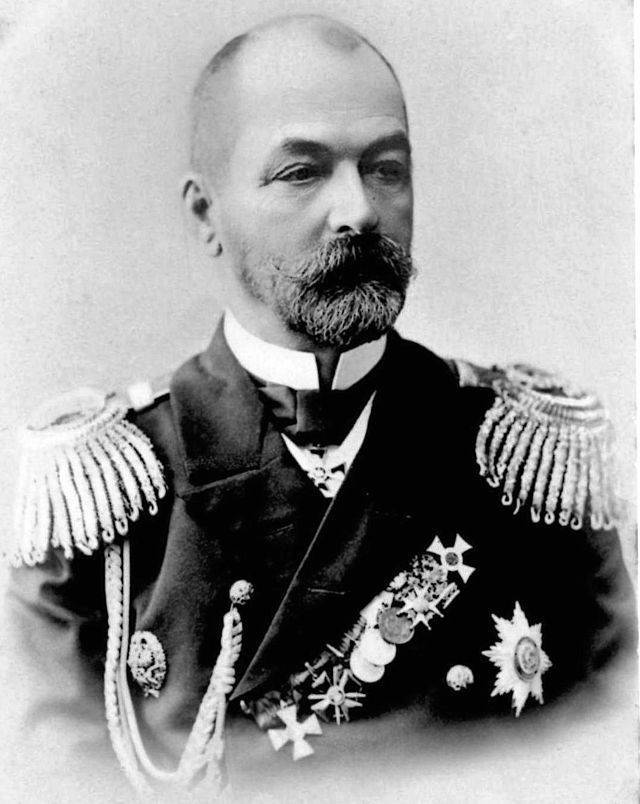
Commander of the Russian squadron Zinovy Petrovich Rozhestvensky
To be continued ...
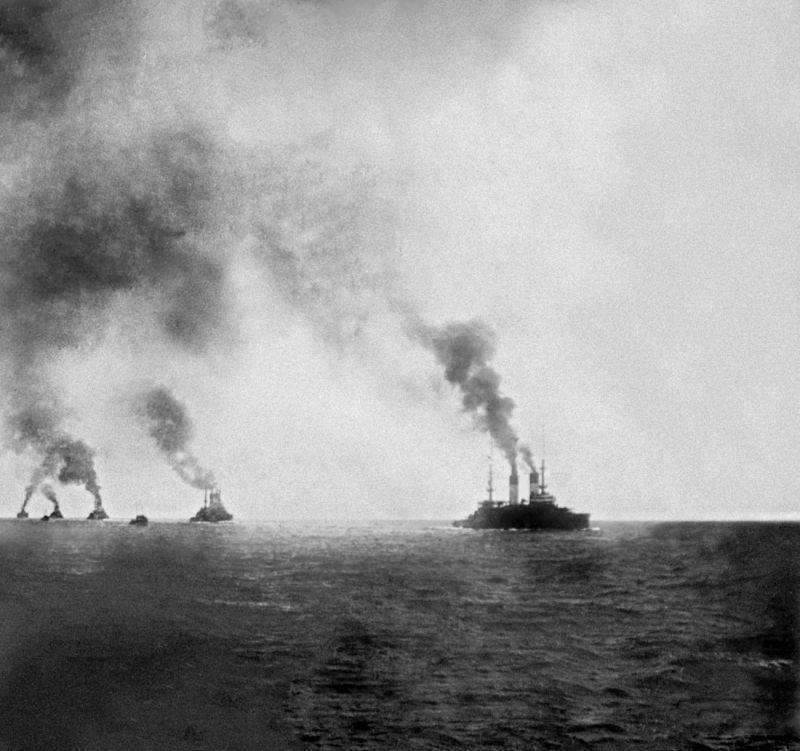

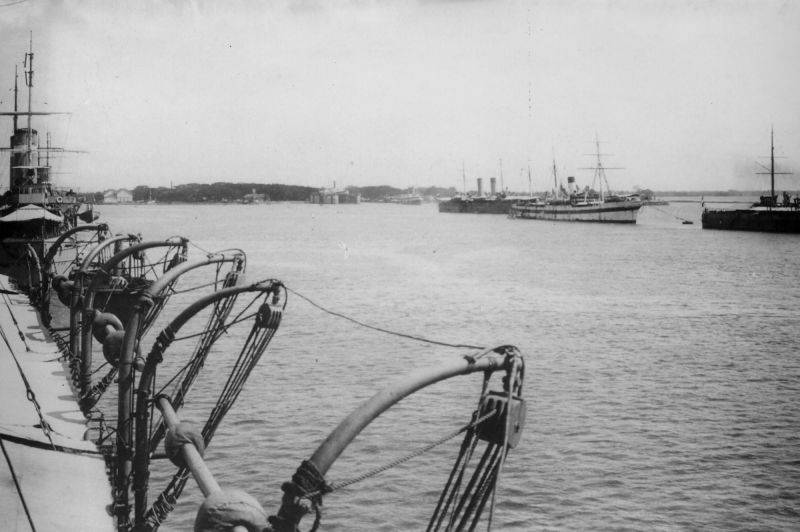
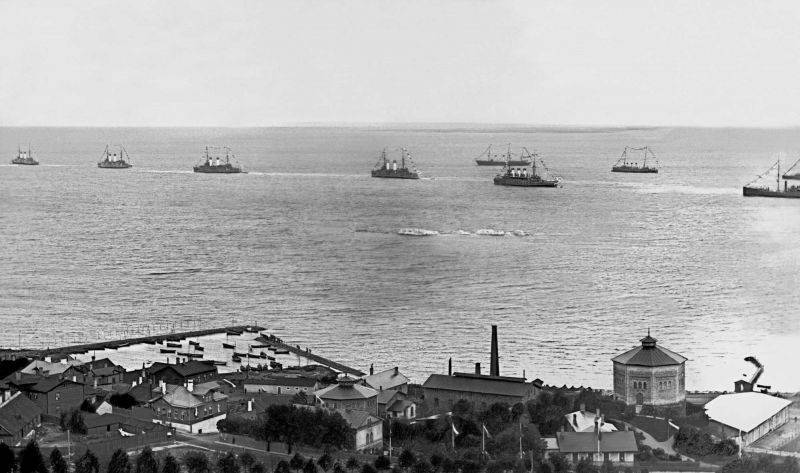
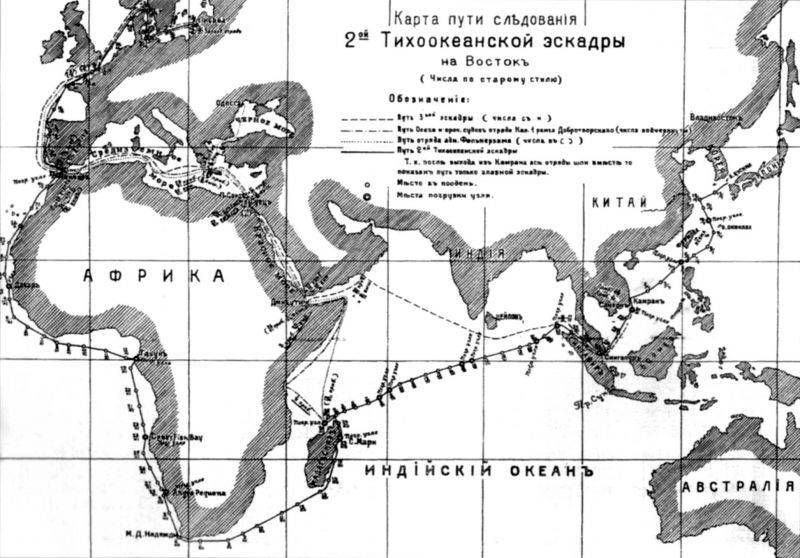
Information